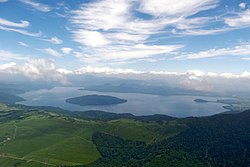Lake Kussharo
| Lake Kussharo 屈斜路湖 |
|
|---|---|

July 2013
|
|
| Location | Teshikaga, Hokkaidō |
| Coordinates | 43°37′39″N 144°19′46″E / 43.62750°N 144.32944°ECoordinates: 43°37′39″N 144°19′46″E / 43.62750°N 144.32944°E |
| Type | acidotrophic crater lake |
| Primary inflows | Atosa River (跡佐川 Atosa-gawa?), Amemasu River, Onnenai River, Shikerepenbetsu River, Onneshireto River, Toikoi River, Meshikimemu River, Enetokomappu River, Ossappe River (尾札部川 Ossappe-gawa?) |
| Primary outflows | Kushiro River (釧路川 Kushiro-gawa?) |
| Basin countries | Japan |
| Surface area | 79.3 km2 (30.6 sq mi) |
| Average depth | 28.4 m (93 ft) |
| Max. depth | 118 m (387 ft) |
| Water volume | 2.25 km3 (0.54 cu mi) |
| Shore length1 | 57 km (35 mi) |
| Surface elevation | 121 m (397 ft) |
| Islands | Nakajima |
| Settlements | Kawayu Onsen and Kotan in Teshikaga |
| References | |
| 1 Shore length is not a well-defined measure. | |
Lake Kussharo (屈斜路湖 Kussharo-ko?) is a caldera lake in Akan National Park, eastern Hokkaidō, Japan. As with many geographic names in Hokkaidō, the name derives from the Ainu language. It is the largest caldera lake in Japan in terms of surface area, and sixth largest lake in Japan. It is also the largest lake in Japan to freeze over completely in winter.
The lake’s central island, Nakajima (not to be confused with another island of the same name in Lake Tōya), is a composite volcano. Volcanic gases render the lake water acidic, and it supports few fish except in areas where inflowing streams dilute the water. Rainbow trout, which are also resistant to fairly acidic water, have been artificially introduced. In 1951, a rare form of cicada (Oncotympana maculaticollis) was discovered, and is now protected by the government. The lake is also on the migratory path of the whooper swan.
Along the lake shore are several outdoor hot springs and a sand beach with naturally heated sand and hot ground water. Wakoto Peninsula extending into the lake has a number of active sulfurous vents.
The lake is also known as Japan’s Loch Ness, after numerous reported sightings on a lake monster dubbed Kusshii by the press from 1973.
Viewed from Tsubetsu Mountain pass.
Viewed from Mt. Mokoto Prospects Park.
...
Wikipedia
